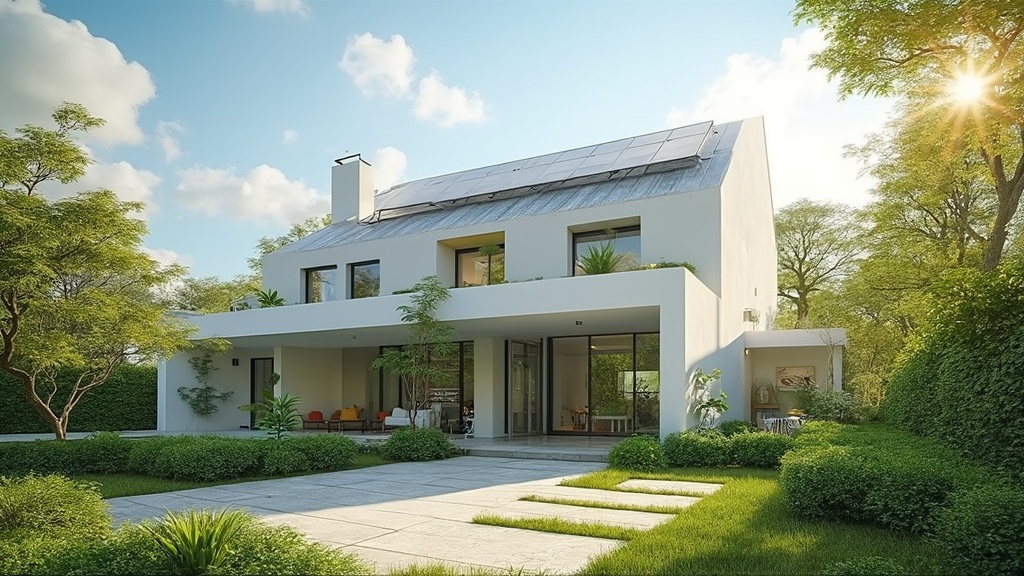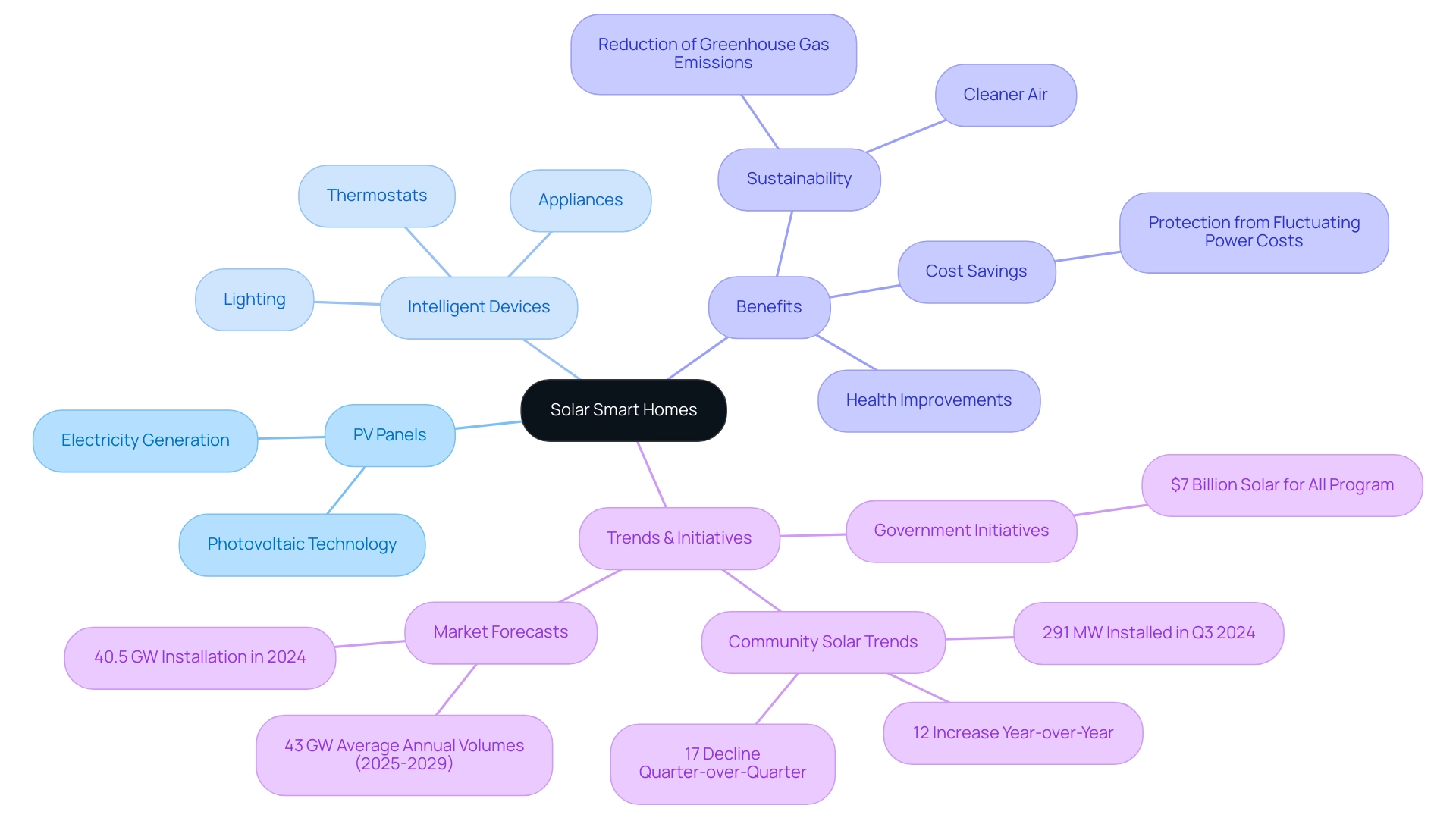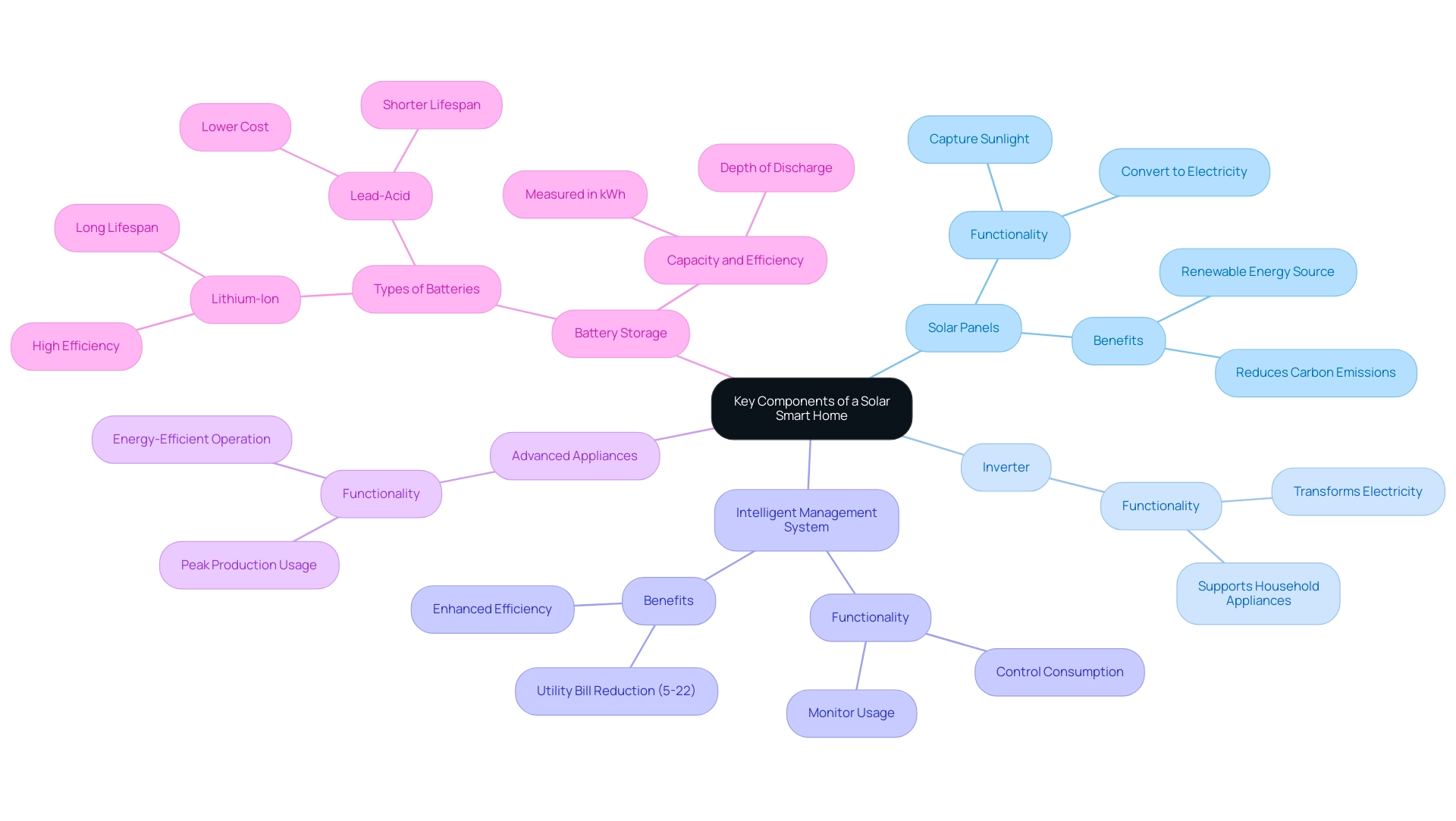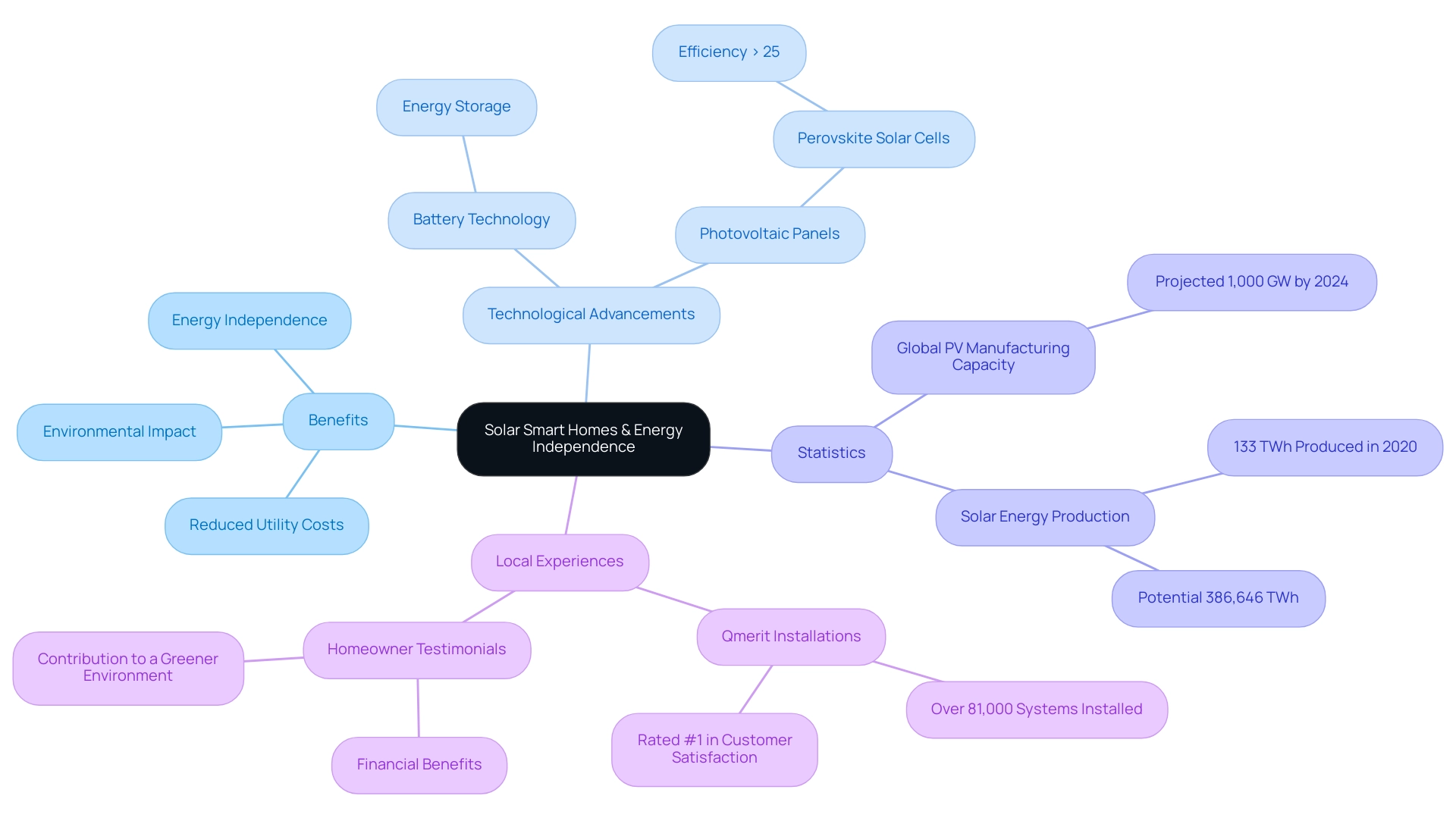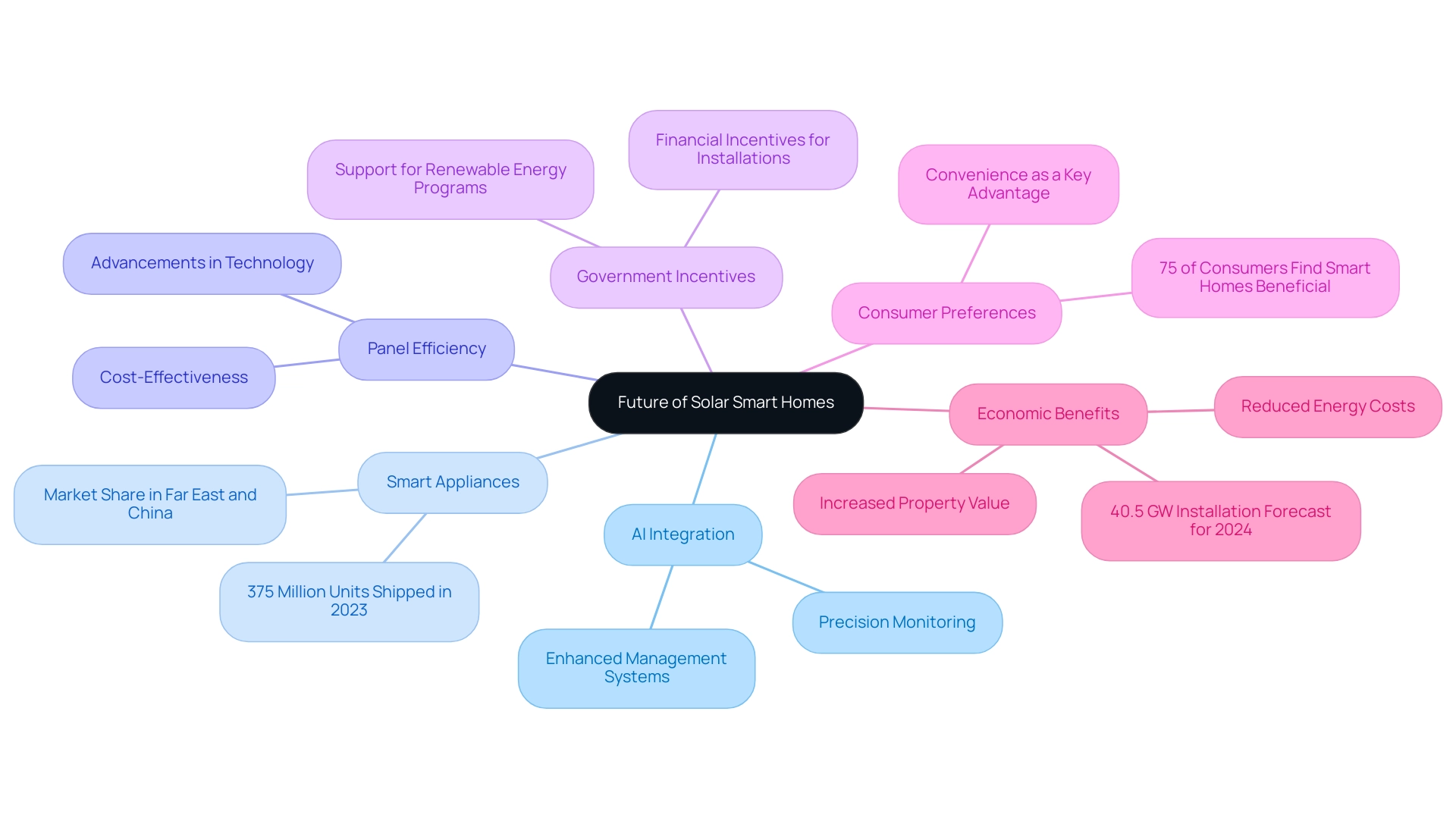Overview
A solar smart home is defined as a residence that integrates solar power systems with advanced technology to optimize energy use and enhance automation, allowing homeowners to manage their power consumption efficiently. The article supports this by detailing how solar panels, intelligent management systems, and advanced appliances work together to reduce reliance on the electrical grid, lower utility costs, and promote sustainability, ultimately contributing to a more eco-friendly living environment.
Introduction
In a world increasingly focused on sustainability, solar smart homes are emerging as a beacon of innovation and eco-conscious living. These homes seamlessly blend solar energy systems with cutting-edge smart technology, allowing homeowners to take control of their energy consumption while contributing positively to the environment.
Imagine effortlessly managing your home’s heating, cooling, and lighting, all powered by the sun, and tailored to your energy needs. This integration not only enhances convenience but also offers significant cost savings and a reduced carbon footprint.
As the solar industry continues to grow, advancements in technology promise to make energy management more intuitive and accessible, paving the way for a future where homes are not just places to live, but also powerful tools for sustainability.
Whether you’re a seasoned eco-warrior or just beginning your journey towards greener living, understanding the components and benefits of solar smart homes can empower you to make informed choices that align with your values and aspirations.
Defining Solar Smart Homes: An Overview of Integration
A solar smart home effortlessly integrates solar power systems with advanced technology, establishing a setting that maximizes resource usage while improving automation. At its core, this novel idea employs photovoltaic (PV) panels to convert sunlight into electricity, combined with intelligent devices that monitor and regulate power consumption throughout the residence. Imagine possessing the ability to remotely manage your heating, cooling, lighting, and appliances in a solar smart home, all tailored to your power production.
For example, an intelligent thermostat can cleverly modify its settings according to the quantity of power produced by your photovoltaic panels, enabling you to optimize your renewable resource utilization and lessen reliance on the electrical grid.
The advantages of combining renewable technology with advanced household features in a solar smart home are not solely about convenience; they also encourage sustainability and financial savings. By investing in a solar smart home with heating systems powered by the sun, you’re not just protecting yourself from fluctuating power costs but also contributing to the reduction of greenhouse gas emissions, supporting job creation in the renewable energy sector, and enhancing public health through cleaner air. With the increase of intelligent household devices—currently, 4.1% of Americans possess advanced microwaves—it’s evident that this trend is about more than just technology; it signifies a commitment to a more sustainable future.
Parks Associates notes,
If a household has a smart home device, they tend to have several,
showcasing the interconnected nature of modern living.
Despite recent challenges, such as the COVID-19 pandemic and geopolitical tensions, the energy industry continues to show resilience. Wood Mackenzie forecasts that the US renewable energy sector will install 40.5 GW in 2024, with strong growth expected in the subsequent years. Community energy, although experiencing fluctuations, underscores both the challenges and opportunities within the energy sector.
Additionally, initiatives like the Biden-Harris administration’s $7 billion Solar for All program aim to enhance access to renewable power, ensuring equitable benefits across communities. As we look forward, innovations in solar smart home technology promise to make power management not only more intuitive but also environmentally friendly, aligning perfectly with your principles as an eco-conscious property owner.
The Benefits of Embracing Solar Smart Home Technology
Embracing solar smart home technology offers numerous benefits that can change how homeowners engage with power. One of the standout advantages is the substantial increase in efficiency, allowing families to monitor their usage in real-time and make adjustments as needed. In fact, 75% of consumers mention convenience as the main advantage of intelligent living spaces, which improves the overall user experience.
This empowerment not only helps homeowners optimize their consumption but can lead to impressive cost savings on electricity bills. For example, numerous families using intelligent renewable systems report eliminating or significantly lowering their monthly utility expenses, reflecting case studies where households have experienced reductions of over 70% in costs through strategic heating solutions. Furthermore, transitioning to renewable sunlight power plays a crucial role in decreasing greenhouse gas emissions, creating a significant effect on the environment.
As emphasized in several case studies, including those from Southern California and the Pacific Northwest, efficient heating technologies can considerably reduce a residence’s carbon footprint, with some systems attaining a 20 to 40 percent reduction in carbon output. Significantly, passive power collection designs, such as residences utilizing large south-facing windows, have shown remarkable efficiency in cooler areas, further highlighting the diverse applications of solar heating technologies. Additionally, sunlight-powered air heaters can decrease a household’s carbon output by 20 to 40 percent and lower monthly utility costs by 30 percent, according to Clean Energy Resource Teams.
The incorporation of advanced residential technology is viewed as an essential move towards reaching international environmental objectives, enhancing efficiency and reducing emissions. As a bonus, these eco-friendly features often enhance property values, as prospective buyers are increasingly attracted to residences equipped with energy-efficient technologies. Overall, the concept of a solar smart home, which combines renewable power with intelligent technology, not only promotes a more sustainable living environment but also cultivates a shared sense of responsibility among homeowners towards conscientious power usage.
Key Components of a Solar Smart Home
Constructing a solar smart home that is powered by sunlight is an exhilarating path toward self-sufficiency and sustainability. At the core of this solar smart home system are several crucial components: solar panels, an inverter, an intelligent management system, advanced appliances, and battery storage. Solar panels are like the sun’s best friends—they capture sunlight and convert it into electricity that powers your home.
The inverter plays a vital role, transforming that electricity into a usable form for all your household appliances.
Understanding Solar Panel Functionality
But it doesn’t stop there! An intelligent resource management system elevates your efficiency to the next level. With a simple smartphone app or web interface, you can monitor and control your usage, ensuring you’re always aware of your consumption patterns.
Homeowners utilizing advanced thermostats and monitoring systems frequently observe utility bill decreases of 5-22%, making these technologies not only environmentally friendly but also economical. Additionally, intelligent devices, like energy-efficient refrigerators and washing machines, can be set to function during peak production times of sunlight. This means you utilize power when it’s most abundant, maximizing your efficiency.
Battery Storage Systems
And let’s not forget about battery storage systems. In a solar smart home, these convenient devices store any surplus solar power for use during overcast days or at night, ensuring you have a continuous supply of renewable resources. It’s essential to choose the correct battery type, as options like lithium-ion and lead-acid can significantly affect your autonomy and economic savings.
For instance, lithium-ion batteries are known for their high efficiency and longer lifespan, while lead-acid batteries are typically more affordable but have a shorter lifespan and lower depth of discharge. A study from Finnish researchers concluded that home automation can save up to 12.78% of original carbon emissions, making your eco-friendly home even greener. This aligns with the broader context of renewable power systems, which provide significant environmental advantages by reducing carbon emissions.
Selecting the Best Solar Batteries
When choosing a solar battery, consider factors such as capacity (measured in kilowatt-hours), depth of discharge, efficiency, and warranty. Top products in the market consist of the Tesla Powerwall, LG Chem RESU, and Sonnen Eco, each providing unique features tailored for various power requirements. Together, these components create a cohesive and efficient ecosystem, allowing you to enjoy the comfort of modern living while contributing positively to the environment.
By comprehending your residence’s power requirements and choosing the finest batteries and inverters, you can customize your system for peak performance and sustainability.
How Solar Smart Homes Contribute to Energy Independence
Solar smart homes are transforming the environment of independence, allowing homeowners to produce, store, and manage their power needs on their own terms. By utilizing the strength of photovoltaic panels, families in Long Beach can turn their homes into a solar smart home, significantly lessening their dependence on the grid, which is particularly advantageous during power outages or sudden increases in utility costs. Recent advancements in battery technology further enhance the independence of a solar smart home, allowing homeowners to store surplus power for use during cloudy days or at night, thus ensuring uninterrupted access to renewable resources.
As stated by the International Energy Agency, resource savings can frequently be achieved through simple technological improvements or minor behavioral adjustments, making the shift to renewable sources more attainable than ever. Exciting advancements such as perovskite photovoltaic cells, capable of converting over 25% of sunlight into power, represent significant leaps forward in efficiency. As the global photovoltaic manufacturing capacity is anticipated to reach almost 1,000 GW by 2024, the potential for power independence is swiftly growing.
However, it’s important to note that the U.S. Department of Energy reported only 133 terawatt-hours of sunlight generated in 2020, out of a potential 386,646 terawatt-hours, indicating a substantial underutilization of renewable resources and the pressing need to optimize our harnessing of power. For Long Beach tenants, programs such as the California Solar Initiative provide incentives for embracing renewable power in their solar smart home, facilitating the transition. Furthermore, companies such as Qmerit, which has installed over 81,000 photovoltaic panel systems across North America with excellent customer satisfaction ratings, demonstrate the increasing acceptance of sustainable power solutions.
Local homeowners have shared positive experiences with energy installations, highlighting not only the financial benefits but also the satisfaction of contributing to a greener environment. This shift not only empowers individuals but also contributes to a more resilient power system, easing the burden on traditional infrastructures and paving the way for a greener and more sustainable future for all.
The Future of Solar Smart Homes: Trends and Innovations
The future of solar smart homes is indeed looking bright, with exciting trends and innovations on the horizon. A key development is the rising integration of artificial intelligence (AI) into management systems, allowing homeowners to monitor and optimize their usage with remarkable precision. In 2023, the market witnessed the delivery of 375 million smart appliances, highlighting the increasing importance of smart technology.
As we approach 2024, advancements in panel efficiency and battery storage are making renewable energy not only more accessible but also more cost-effective than ever before. Recent insights into Tesla chargers reveal their role in enhancing the convenience of electric vehicle ownership, while government renewable energy programs provide financial incentives that make installations more attainable for property owners. Additionally, top solar panel cleaning services ensure optimal performance and longevity of solar systems.
Smart devices are becoming increasingly interconnected, facilitating seamless communication between appliances, energy systems, and personal preferences. As Barry Elad, a Senior Writer, observed, ‘75% of consumers found intelligent residences to be more advantageous than anticipated, as convenience was the most mentioned advantage.’ These technological evolutions promise that the concept of a solar smart home will not only make living more efficient but also more user-friendly, making the transition to a greener lifestyle feel natural and rewarding.
Furthermore, the economic benefits of photovoltaic systems, such as reduced energy costs and increased property value, along with their environmental advantages, reinforce the importance of innovation in renewable technology as we look towards a sustainable future. Forecasts indicate that the US solar industry will install 40.5 GW in 2024, highlighting anticipated growth despite challenges such as labor availability and equipment constraints.
Conclusion
Embracing solar smart home technology is an exciting step toward a more sustainable and energy-efficient future. By integrating solar energy systems with smart devices, homeowners can optimize their energy consumption while enjoying the convenience of modern automation. This combination not only leads to significant cost savings but also plays a crucial role in reducing greenhouse gas emissions, showcasing a commitment to environmental stewardship.
The key components of a solar smart home—such as solar panels, smart energy management systems, and battery storage—work together to create a seamless energy ecosystem. With real-time monitoring and control, families can maximize their solar energy use, ensuring they harness the power of the sun whenever possible. As advancements in technology continue to emerge, the potential for energy independence grows, allowing homeowners to take charge of their energy needs and reduce their reliance on traditional power sources.
Looking ahead, the future of solar smart homes is bright, with innovations that promise to enhance efficiency and accessibility. The integration of artificial intelligence and improved solar panel technologies will make it easier than ever for households to adopt renewable energy solutions. As awareness and interest in sustainable living continue to rise, solar smart homes will not only contribute to individual savings but also foster a collective movement towards a greener, more resilient future for everyone.


